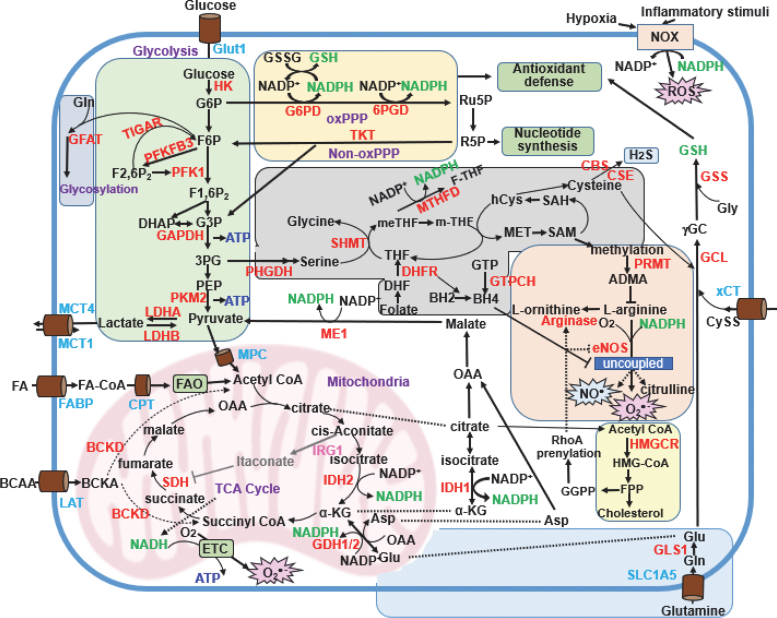FIG. 4.
Cellular metabolic pathway involved in redox homeostasis. The major metabolic pathways that regulate redox homeostasis in ECs are as shown. Parts of metabolic pathways that take place in immune cells (e.g., those involving itaconate) are also included. Metabolic pathways that regulate redox homeostasis are limited to those involved in the production of NADPH and GSH (shown in green) and that regulate eNOS activity (shown in red). The ECs primarily utilize glycolysis (shaded in green) to obtain ATP. During this process, ECs generate pyruvate and lactate from glucose, thereby contributing to four additional pathways. The first of these, known as the PPP (shaded in yellow), includes both oxPPP and non-oxPPP pathways that contribute to antioxidant defense and nucleotide synthesis, respectively. Second, 1C metabolism (shaded in gray) contributes to protein and nucleotide methylation. Third, the hexosamine pathway (shaded in blue) uses F6P to promote protein glycosylation and synthesis of the luminal glycocalyx. Finally, after glycolysis, pyruvate can enter the mitochondria where it is converted to acetyl-CoA and can then enter the TCA cycle (shown in purple). NADPH is essential not only for antioxidant defense pathways, including the PRX/TRX and GPX/GSH systems that mitigate ROS-related cellular damage, but it is also necessary for the generation of NO• (a cofactor for NOS) and O2•− (a cofactor of the NOX enzymes). The major metabolic pathways that generate NADPH include oxPPP, ME1, 1C metabolism, IDH1/2, glutamine metabolism, and CPT1-mediated FAO. De novo synthesis of the antioxidant, GSH (shown in green) involves CySS import into the cell via the CySS/glutamate transporter (xCT), cysteine generated from methionine via the transsulfuration pathway, and glutamine metabolism. Cysteine is also involved in the synthesis of the gaseous transmitter, H2S. The primary metabolic pathways contributing to coupled and uncoupled eNOS include the ornithine cycle (shaded in pink), the mevalonate pathway (shaded in pale blue), and 1C metabolism (via BH4). Lastly, itaconate synthesized from aconitate in activated macrophages via the actions of IRG1 inhibits the activity of SDH. This inhibits ROS generation by RET at complex I. CPT1, carnitine palmitoyltransferase-1; CySS, cystine; EC, endothelial cell; eNOS, endothelial NOS; FAO, fatty acid oxidation; H2S, hydrogen sulfide; IRG1, immune-responsive gene 1; LDH, lactate dehydrogenase; oxPPP, oxidative PPP; xCT, the cystine/glutamate antiporter SLC7A11. Color images are available online.

